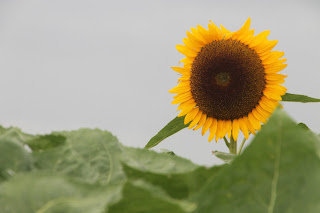Monday, June 24, 2013
The Art of Seeing, Day four
The pictures above are from yesterday. The lighting is terrible on all of them.
Below are from today. All of today's pictures are on a automatic setting. I was doing a bit of driving and wanted to just capture some scenes.
I had really hoped these red-winged blackbird (one of my absolute favorite birds, maybe my favorite bird call of all) would be great. Instead they are unimpressive. The beautiful bird is not close enough and the sunflowers are not right. Maybe they are too thin of a strip to be a factor?
This might be the best composition but it still doesn't work. The sunflowers are too out of focus or too something to add to the photo. The placement of the bird doesn't do anything either.
I sure do love a dirt road in a photograph.
My beautiful girls, always a lovely photo, no matter how tired and dirty.
There is something I love about these deader-than-Hector sunflowers below. This one might be my favorite of the sunflower photographs.
In the picture below, I was hoping the leaves would look like the sea.
Ok, so this picture below has too much exposure. It shines out the textures. This is a good example of picture that would have been better on manual (if I knew what I was doing).
Again, I had high hopes for this photo below, but on manual there just isn't the texture and contrast that the picture needs.
Corn shots. Blah. Did not turn out as interesting in reality as I'd envisioned.
I thought this was hilarious: "It has all burned to hell. Would you like to buy it?"
This is a photograph I'm going to work on. I need better light and to be up closer. I just love this rusted billboard though.
Thursday, June 20, 2013
The Art of Seeing, Day Three
No, I have not gone crazy. I haven't even gone a bit bananas. But, this well may be the most boring post you'll ever read.
Part of the reason I chose to take this ecourse is because I want to use the manual settings on my camera more frequently (read : at all). I feel like I am not completely inept when it comes to photograph composition. But light and grain and movement and focus are all out of my comfort zone.
So today I thought I would play with f-stop. F-stop is the number that tells how large the aperture (hole that lets in light) is. Pretty basic. The only tricky thing is the number. The smaller the number the larger the hole. I think about those plugs people put in their ears. Gauge. The larger the number, the smaller the hole.
This first set of pictures is without the flash. The first of these pictures is with the smallest f-stop; the f-stop opening up a bit with each subsequent frame, stopping at about f-18.
This second set of pictures is with the flash. The first picture, below, has the lowest aperture setting (most light in). Then I closed the aperture a little more with each picture. The first picture is the f-stop of 2.8, the last f-29.
I'm not exactly sure what I learned from this lesson. Without the flash, it is easier to see the gradient light. With the flash, I'm not sure I notice any difference.
Part of the reason I chose to take this ecourse is because I want to use the manual settings on my camera more frequently (read : at all). I feel like I am not completely inept when it comes to photograph composition. But light and grain and movement and focus are all out of my comfort zone.
So today I thought I would play with f-stop. F-stop is the number that tells how large the aperture (hole that lets in light) is. Pretty basic. The only tricky thing is the number. The smaller the number the larger the hole. I think about those plugs people put in their ears. Gauge. The larger the number, the smaller the hole.
This first set of pictures is without the flash. The first of these pictures is with the smallest f-stop; the f-stop opening up a bit with each subsequent frame, stopping at about f-18.
This second set of pictures is with the flash. The first picture, below, has the lowest aperture setting (most light in). Then I closed the aperture a little more with each picture. The first picture is the f-stop of 2.8, the last f-29.
I'm not exactly sure what I learned from this lesson. Without the flash, it is easier to see the gradient light. With the flash, I'm not sure I notice any difference.
Subscribe to:
Posts (Atom)























































